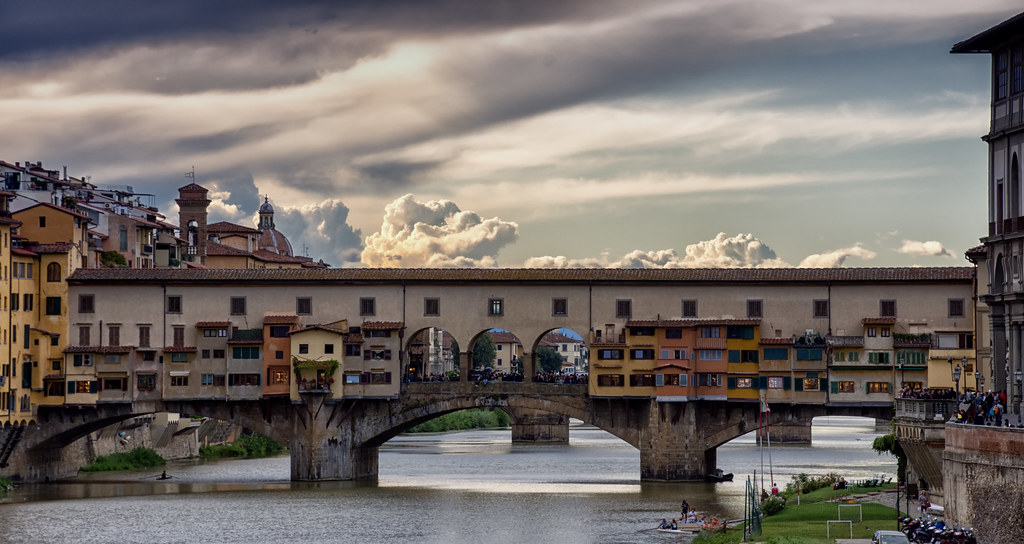Ponte Vecchio in Florence, Italy


Ponte Vecchio is to Florence what the Colosseum is to Rome, and its image is the best known and most representative of the city. The Ponte Vecchio is the symbol of romanticism that floods all of Florence.
The origins of the «Old Bridge» date back to 1345, which makes it the oldest stone bridge in Europe.
In the 15th and 16th centuries, its hanging houses were occupied by butchers and slaughterers, but when the court moved to the Pitti Palace, Fernando I ordered the shops closed because of the bad smell. Since then the stores have been occupied by jewelers and goldsmiths.
Another curious detail of the time was the construction of the Vasari Corridor, a corridor that crosses the eastern part of the bridge from the Palazzo Vecchio to the Palazzo Pitti.
During the Second World War, the Ponte Vecchio was the only one of the bridges of Florence that was not destroyed by the German troops.
Many centuries ago, bridges served many purposes. Apart from allowing you to pass over water, it was common for medieval bridges to have chapels and houses built on them, and many were fortified with towers and walls, because the bridges served as important points of entry to the cities. The Ponte Vecchio or the «Old Bridge» over the Arno River, in Florence, Italy, is a medieval stone bridge known for keeping shops built along it.

The first bridge over the Arno River, probably was built by the Romans in stone and wood and is mentioned in a document dating from 996. The bridge was dragged by a flood in 1117 and was rebuilt in stone only to be destroyed again by another flood in 1333, except for its two central pillars. Consequently, the bridge was rebuilt, twelve years later, designed by the Italian painter and most talented architect Giotto’s disciple, Taddeo Gaddi, who was a painter and architect on his own merits.
Today, the Arno River is crossed by six bridges, all of which can be crossed on foot or by vehicle, except Ponte Vecchio, which does not allow vehicle traffic. That’s because this iconic medieval bridge is always full of buyers.
Shops of the Ponte Vecchio
Ponte Vecchio has been home to shops through its extension since the 13th century. Merchants sold their wares on boards after receiving approval to do so from the competent authorities. When a merchant could not pay his debts, the table on which he sold his merchandise (the «Bank») was physically broken («rotto») by the soldiers, effectively closing his business. This practice is called «bancorotto» and it is believed that the economic concept of bankruptcy (bacarrota) originated here.
The stores belonged to the Commune and were rented, originally for butchers, fishmongers, and tanners. But these merchants produced so much garbage and stench that Duke Ferdinando de Medici threw them out and replaced them with goldsmiths. The problem was that the Vasari Corridor that connects the town hall of Florence, with the palace of the ruling family, passes over the Ponte Vecchio and tunia to withstand the nauseating smell. So the duke decided that the new occupants of the bridge should be goldsmiths. Jewelers still make up the majority of Ponte Vecchio stores today. In fact, some of the best jewelers in Florence sell their creations on this medieval bridge. There are also some art studios and souvenir shops.

Towards the 15th century, the stores that were originally for rent were sold to private owners and began to alter the superstructure by adding exterior terraces and rooms that extended to the river supported by wooden supports. In the 17th century the bridge had acquired the chaotic appearance that we see today.
During the Second World War, when the Germans withdrew from Italy to Germany, they destroyed many beautiful bridges in Italy to prevent the advance of the allies. All the bridges in Florence were blown up, but Ponte Vecchio was saved. Instead, they blocked access by demolishing the medieval buildings on each side. Even Adolf Hitler recognized that the destruction of Ponte Vecchio would be a crime too great.
The three central arched windows were added in 1938 by Mussolini for the benefit of Adolf Hitler, so that the Führer could enjoy a good view of Florence, when he was invited for a state visit.
The padlocks of the Ponte Vecchio
In addition to its hanging houses, if there is something that characterized the bridge for years was the number of padlocks that were placed on it as a sign of love.
At the moment the rite continues working, but every very little time the authorities remove the padlocks for the security of the structure.
Location:
Between Via Santa Maria and Via dei Guicciardini
How to get:
Buses: lines D and C3.